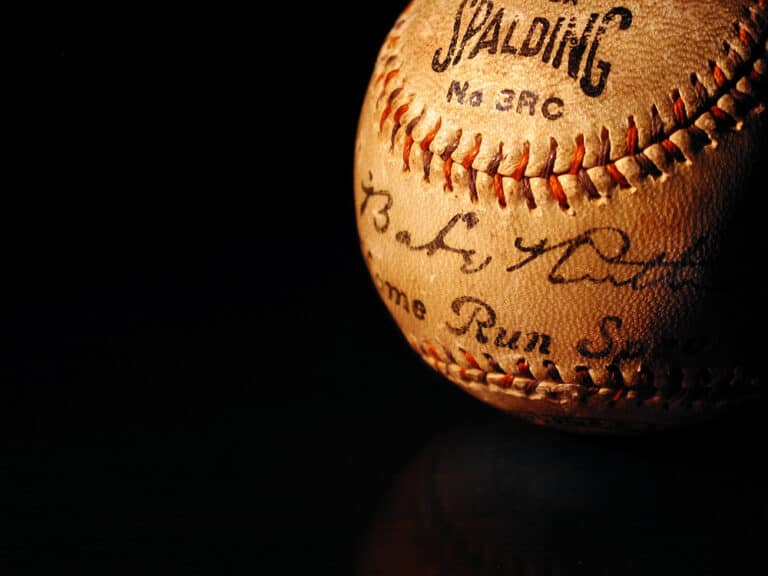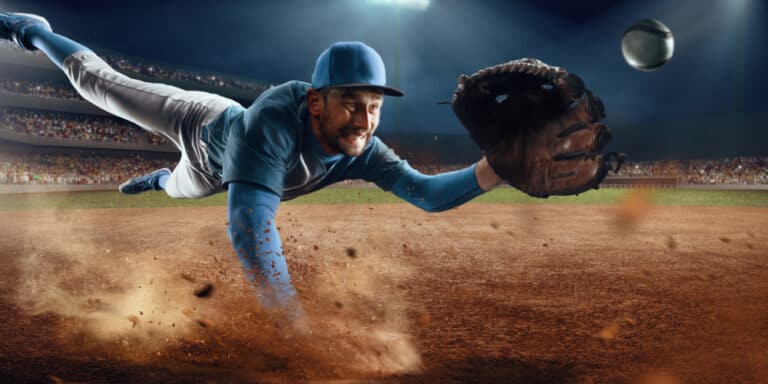Average Baseball Throw Speed (All The Data Inside!)
The processes which happen in a batter’s brain when a pitcher throws a ball are simply incredible. A 100-mph ball will take roughly 375-400 milliseconds to reach the plate, and in that time, the batters have 75-100 milliseconds to identify the ball, 100ms to calculate the speed and angle, 150ms to decide if it is a fair ball or foul, and between 50ms to 75ms to hit it.
The average baseball throw speed varies due to several different factors. The most obvious is age, and where an under eleven-year-old will generally be able to pitch a ball at between 30mph to 40 mph, a professional adult may be able to achieve speeds of up, and even over, to 100mph.
However, the ability to throw the ball fast occasionally is not what constitutes a good pitcher. Being able to pitch a board at a consistently high speed accurately and being able to move it around is the skillset required by a match-winning pitcher.
What Is The Average Throw Speed?
Anyone who understands and follows baseball will agree that the pitcher’s ability and the speed he or she can throw the ball will determine the results on the mound.
A combination of natural talent, practice, and refining of the technique are what makes the difference between an average person throwing at 40 mph to 60 mph and the record 110.5 mph set by Aroldis Chapman in 2010.
For someone who has had no training and practice, they would be lucky to throw faster the 40 mph.
The averages that trained players can achieve generally vary by age For young, trained players, the average pitching velocity ranges as follows.
- 40-50 mph among nine and ten-year-olds.
- 55-75 mph between eleven and seventeen years old’s.
- Average of 80 mph for 18-year-olds and above.
- Average of 92.8 mph for a major league baseball pitcher.
The following list is the fastest AVERAGE speed four-seam fastballs between 2007 and 2014.
| Starters (200 pitch minimum) | Average velocity (mph) |
| Yordano Ventura (Kansas City Royals) | 98.19 |
| Carlos Martinez (St. Louis Cardinals) | 97.73 |
| Gerrit Cole (New York Yankees) | 96.79 |
| Matt Harvey (Baltimore Orioles) | 96.59 |
| Nathan Eovaldi (Boston Red Sox) | 96.36 |
| Relievers (200 pitch minimum) | Average velocity (mph) |
| Bruce Rondon (Detroit Tigers) | 100.34 |
| Aroldis Chapman (New York Yankees) | 99.45 |
| Joel Zumaya (Detroit Tigers) | 99.27 |
| Kelvin Herrera (Kansas City Royals) | 99.18 |
| Henry Rodriguez (Montreal Expos, Chicago Cubs, Los Angeles Dodgers, New York Yankees) | 98.78 |
How Important Is The Ability To Throw A Fast Ball?
While it is important to have the skill to throw a fastball, this is not the only quality of a great pitcher.
Great pitchers need
- Very high accuracy
- Velocity
- Movement
- A healthy arm
Thousands of young baseball players who may be able to throw very fast will never make it beyond the lower minor leagues because they never achieve an acceptable level of control.
Baseball is largely about pitching and because of this, control is needed. The pitcher should have the ability to throw pitches that look like strikes to batters and get them to chase these.
The Fastball is still the pitch that most pitchers aim for, but a fast pitch can only take a pitcher so far because batters will eventually get it timed and start hitting them.
What ends up distinguishing a good pitcher from a great pitcher is, having movement on his pitches, accuracy in locating the pitches, the mental toughness to keep hammering on and the ability to vary pitches.
Being able to achieve a high pitching speed without injuring the pitcher’s arm, it is essential that techniques are rigorously practiced and refined. The following is a list of the mechanical actions which should be concentrated on.
- The position of the pitcher’s foot on the rubber.
- The pitcher shifted weight correctly.
- Hand break.
- The pictures arm action.
- The position of the back leg before the hand break.
- The action of the leading leg.
- The pitcher’s posture.
- The pitcher’s stride length.
- Early hip rotation.
- Completion of back leg drive.
- The pitcher’s Landing position and the stability of the landing leg.
- The bracing action of the front leg and hip.
- Early rotation of the body trunk.
- The position of the ball when it is released.
- The action of the back foot when the ball is released.
- The amount of pitcher leans at the ball release.
- Having a bad arm-cocked position at the point of landing.
- Having the ball in close to the pitcher’s head at landing.
- How the ball comes out of the pitcher’s glove
- The position of the pitcher’s back leg before the shift in weight.
- The pitchers finishing position
A great pitcher has a huge (almost a controlling) influence in the game simply because he is able to stop most of the great hits.
What Is The Difference?
The differences between the slowest and fasted pitchers are due to the following factors.
- Age
- Bulk
- Technique
The Age Of The Player
The age of the pitcher plays a very strong role in the speed the player can pitch.
While it is impossible to tag the speed, age will always pitch because there will always be that outlier who proves the exception that breaks the rule.
Under Eleven Years Old
Kids under 11 years old have not yet git the muscle mass and strength that comes during and after puberty, so their pitches are naturally slower.
The average age group seems to be between 30 and 40mph.
Under Thirteen Years Old
The boys will just be starting puberty, and there will be the beginning of muscle mass growth and a growth spurt to become taller.
Speeds have increased by approximately 10 mph, and they are consistently pitching at 40mph to 50mph.
Under Fifteen Years Old
This is the end of little league, and these players are starting to look at high school. They are starting to bulk up, and that is demonstrated in the higher pitching speeds of between
45mph to 75mph.
Under 19 Years Old
18-year-olds. With such a wide age range, high school players are often subdivided into smaller groups.
The players begin to specialize, and bulk has grown, as has muscle mass, and speeds of 60-85 mph are not unheard of.
19 Years Old And Over
These guys are at college, minor, and ultimately the major leagues and speeds over 80mph are the norm.
Bulk Improves Pitching Speed
Research has proven that the cliché of “mass equals gas” is factual, and the more mass a pitcher has, the greater the pitching speed.
Apart from learned technique, this is the biggest difference between a prepubescent player and an eighteen-year-old player.
Don’t miss out on that peanut jelly sandwich!
Technique Improves Pitching Speed
It is impossible to discuss all the exercises which can be employed to improve pitching speed.
The most effective way to improve pitching speed is to become involved in a formal training program and put in the hours necessary. With training speed increases by up to 20% can be achieved.
With training, the speed will hopefully increase without affecting accuracy and consistency.

Conclusion
A pitcher capable of record-breaking speeds who cannot consistently position the ball and vary the speed with pinpoint accuracy will soon find his match in the batter. However, there are pitchers in the hall of fame who never exceeded 90mph but were able to do so with precision, accuracy, and skill.







